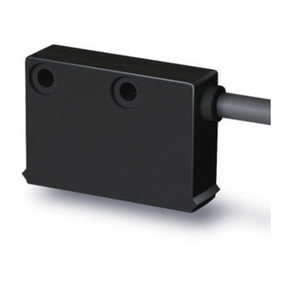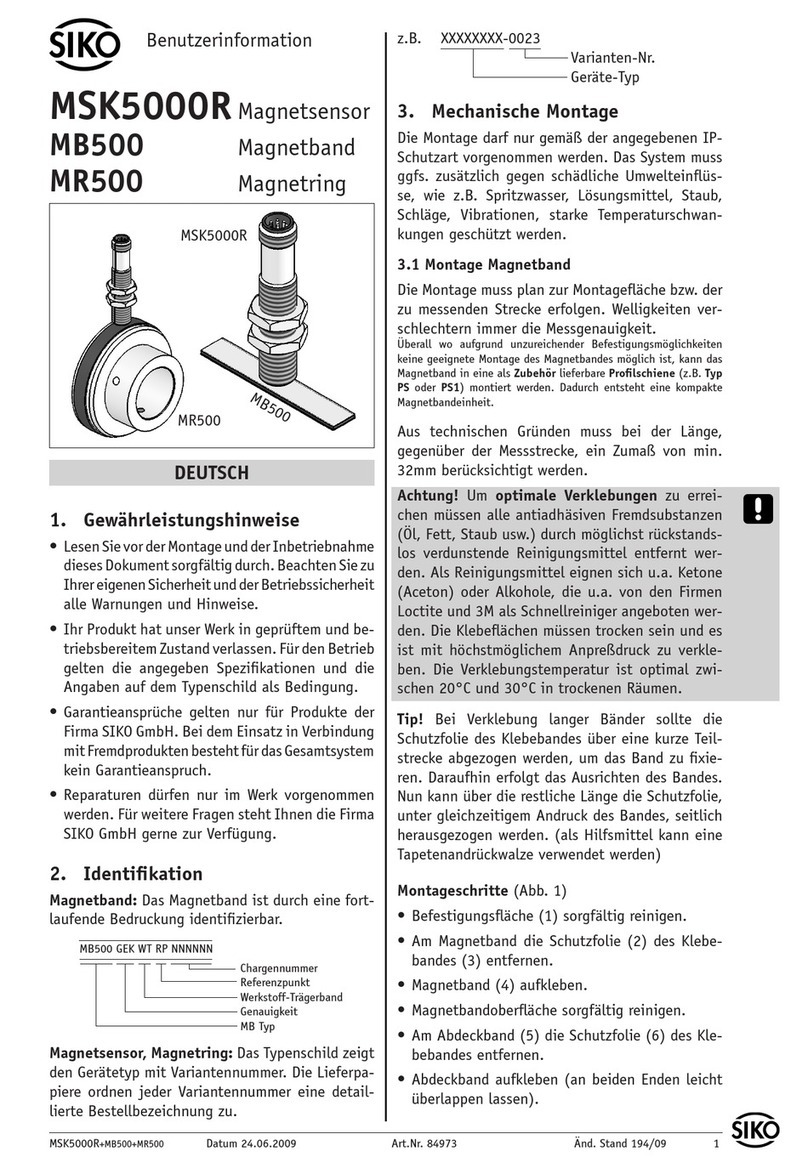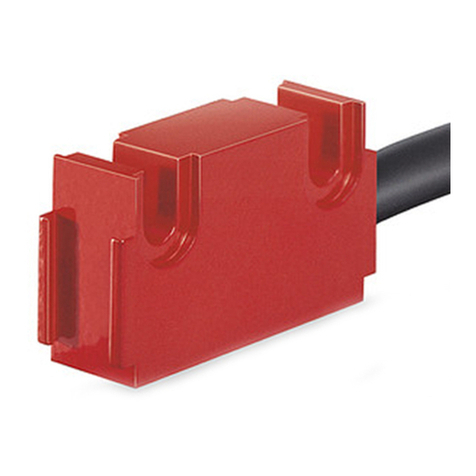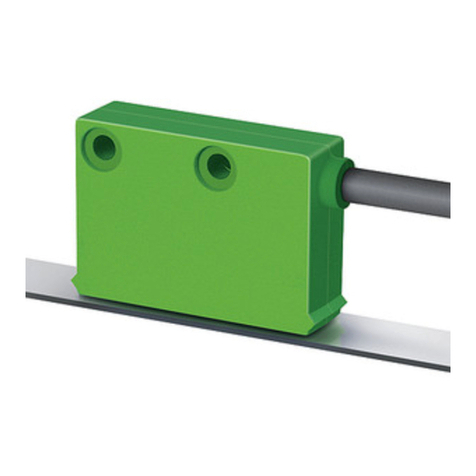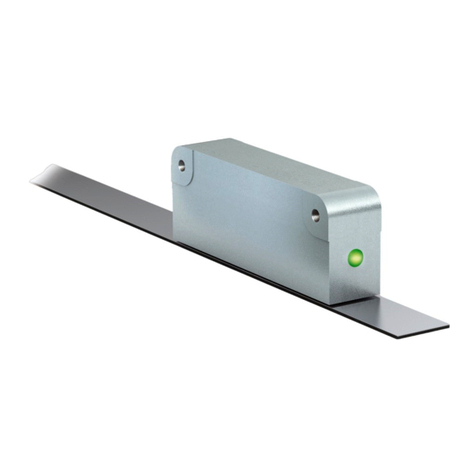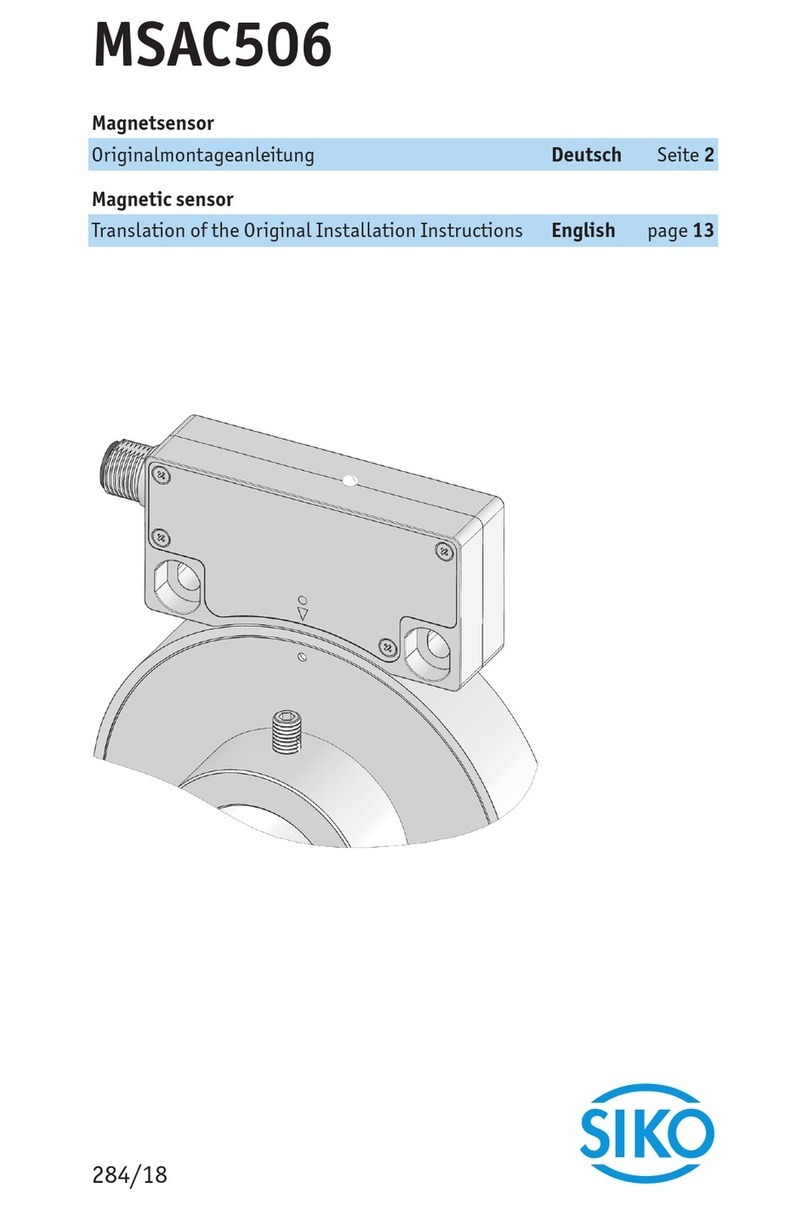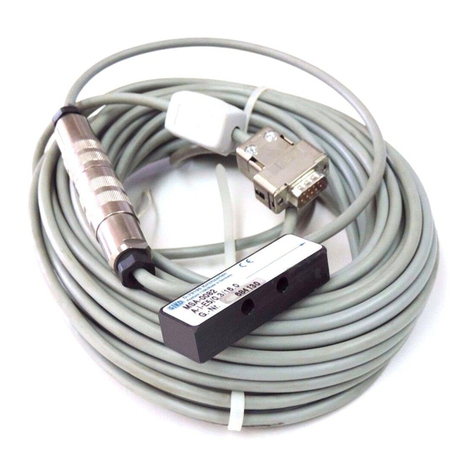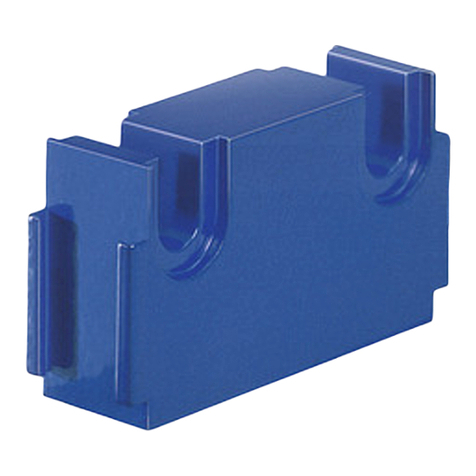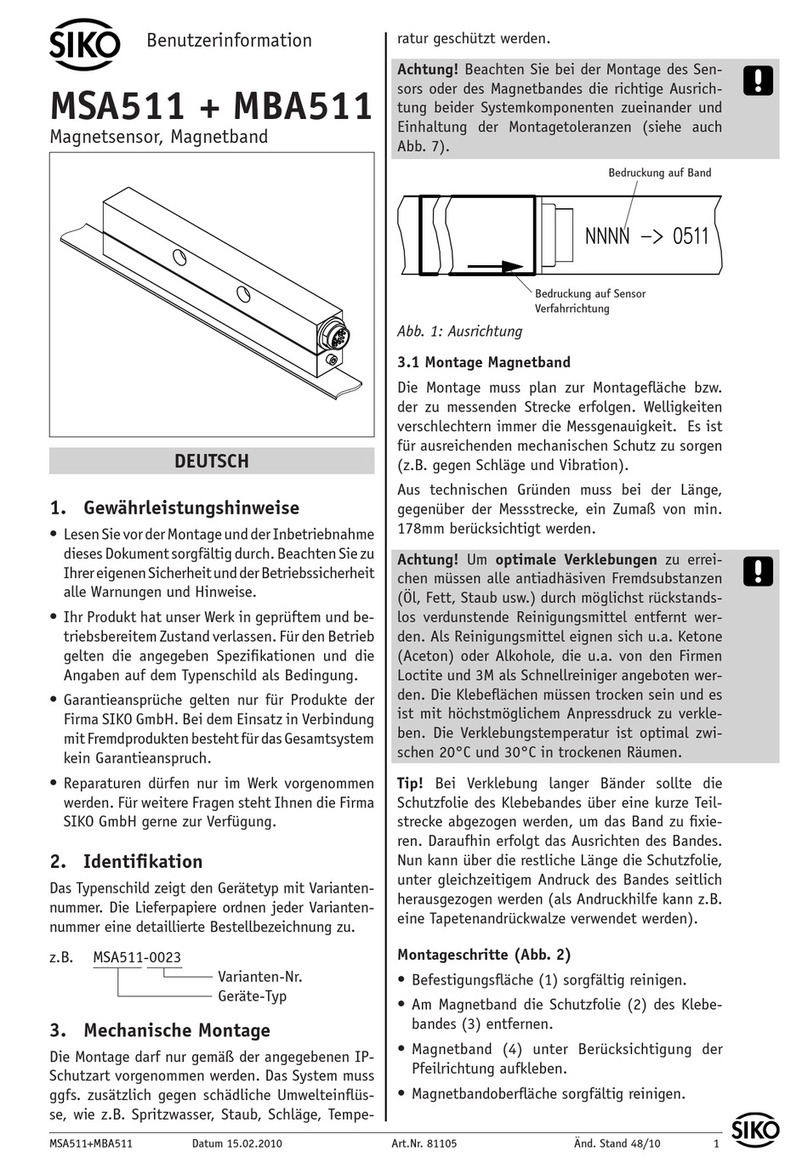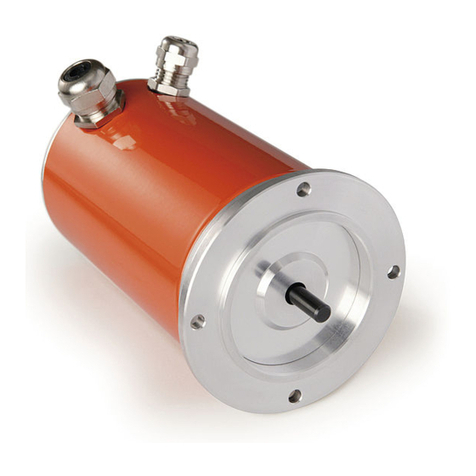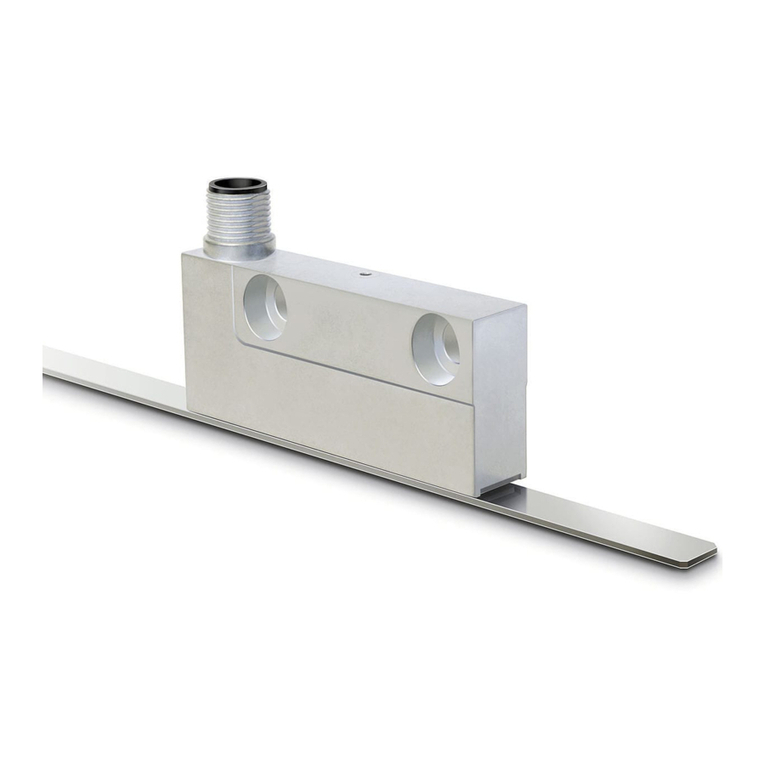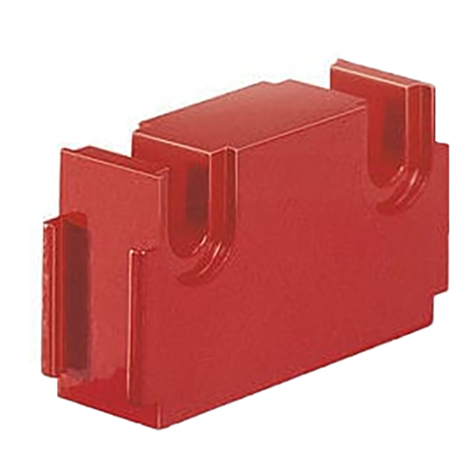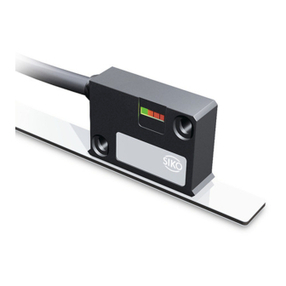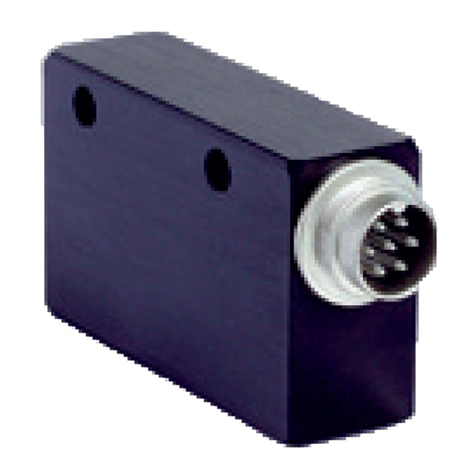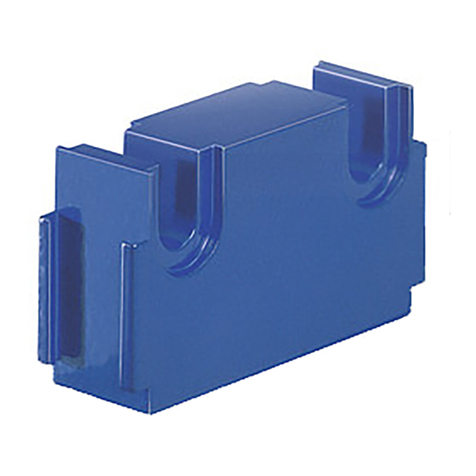Siko LS100 Operation manual

LS100+MB100 Datum 26.08.2008 Art.Nr. 79593 Änd. Stand 318/08 1
DEUTSCH
1. Gewährleistungshinweise
Lesen Sie vor der Montage und der Inbetriebnahme
dieses Dokument sorgfältig durch. Beachten Sie zu
Ihrer eigenen Sicherheit und der Betriebssicherheit
alle Warnungen und Hinweise.
Ihr Produkt hat unser Werk in geprüftem und be-
triebsbereitem Zustand verlassen. Für den Betrieb
gelten die angegeben Spezifikationen und die
Angaben auf dem Typenschild als Bedingung.
Garantieansprüche gelten nur für Produkte der
Firma SIKO GmbH. Bei dem Einsatz in Verbindung
mit Fremdprodukten besteht für das Gesamtsystem
kein Garantieanspruch.
Reparaturen dürfen nur im Werk vorgenommen
werden. Für weitere Fragen steht Ihnen die Firma
SIKO GmbH gerne zur Verfügung.
2. Identifikation
Magnetband: Das Magnetband ist durch eine fort-
laufende Bedruckung identifizierbar.
Beispiel Magnetbandbedruckung:
•
•
•
•
z.B. LS100-0023
Varianten-Nr.
Geräte-Typ
3. Mechanische Montage
Die Montage darf nur gemäß der angegebenen IP-
Schutzart vorgenommen werden. Das System muss
ggfs. zusätzlich gegen schädliche Umwelteinflüs-
se, wie z.B. Spritzwasser, Lösungsmittel, Staub,
Schläge, Vibrationen, starke Temperaturschwan-
kungen geschützt werden.
3.1 Montage Magnetband
Die Montage muss plan zur Montagefläche bzw. der
zu messenden Strecke erfolgen. Welligkeiten ver-
schlechtern immer die Messgenauigkeit.
Aus technischen Gründen muss bei der Länge,
gegenüber der Messstrecke, ein Zumaß von min.
47mm berücksichtigt werden.
Achtung! Um optimale Verklebungen zu errei-
chen müssen alle antiadhäsiven Fremdsubstanzen
(Öl, Fett, Staub usw.) durch möglichst rückstands-
los verdunstende Reinigungsmittel entfernt wer-
den. Als Reinigungsmittel eignen sich u.a. Ketone
(Aceton) oder Alkohole, die u.a. von den Firmen
Loctite und 3M als Schnellreiniger angeboten wer-
den. Die Klebeflächen müssen trocken sein und es
ist mit höchstmöglichem Anpressdruck zu verkle-
ben. Die Verklebungstemperatur ist optimal zwi-
schen 20°C und 30°C in trockenen Räumen.
Tip! Bei Verklebung langer Bänder sollte die
Schutzfolie des Klebebandes über eine kurze Teil-
strecke abgezogen werden, um das Band zu fixie-
ren. Daraufhin erfolgt das Ausrichten des Bandes.
Nun kann über die restliche Länge die Schutzfolie,
unter gleichzeitigem Andruck des Bandes, seitlich
herausgezogen werden. (als Hilfsmittel kann eine
Tapetenandrückwalze verwendet werden)
Montageschritte (Abb. 1)
Befestigungsfläche (1) sorgfältig reinigen.
Am Magnetband die Schutzfolie (2) des Klebe-
bandes (3) entfernen.
Magnetband (4) aufkleben. Aktive Fläche nach
oben, erkennbar am Aufdruck.
Magnetbandoberfläche sorgfältig reinigen.
Am Abdeckband (5) die Schutzfolie (6) des Kle-
bebandes entfernen.
Abdeckband aufkleben (an beiden Enden leicht
überlappen lassen).
Die überlappenden Enden des Abdeckbandes gegen
Ablösen sichern.
•
•
•
•
•
•
•
Benutzerinformation
LS100 + MB100
Mangetsensor und Magnetband
Polbreite: 1mm
Bandgenauigkeit: 0.02mm
Seriennummer
0
2
NNNN 1000
Magnetsensor: Das Typenschild zeigt den Ge-
rätetyp mit Variantennummer. Die Lieferpapiere
ordnen jeder Variantennummer eine detaillierte
Bestellbezeichnung zu.

2 LS100+MB100 Datum 26.08.2008 Art.Nr. 79593 Änd. Stand 318/08
Abb. 1: Montage Magnetband
Abb. 2 Abb. 3
Abb. 4 Abb. 5
Abb. 6: Definition der Zählrichtung
Kabelabgangsrichtung
Verfahrrichtung Sensor,
Cosinus vor Sinus
Abb. 7: Ausrichtung des Sensors
aktive Seite
Abstand Sensor/Magnetband
<1° <3°
maximale Fluchtungsfehler
<3°
Achtung! Die Beeinflussung durch magnetische
Felder ist zu vermeiden. Insbesondere dürfen keine
Magnetfelder (z.B. Haftmagnete oder andere Dau-
ermagnete) in direkten Kontakt mit dem Magnet-
band geraten. In stromlosem Zustand werden Be-
wegungen oder Verstellungen des Magnetsensors
von der Folgeelektronik nicht erkannt und erfasst.
Montagebeispiele
Die einfache Montageart, durch angeschrägtes
Schutzband (Abb. 2), ist nur in sehr geschützter
Umgebung zu empfehlen. Bei ungeschützer Um-
gebung besteht Abschälgefahr. In solchen Fällen
sind Montagearten wie in Abb. 3 und 4 gezeigt,
geeigneter.
Den optimalen Schutz bietet die Montage in ei-
ner Nut (Abb. 5), die so tief sein sollte, dass das
Magnetband vollständig darin eingebettet werden
kann.
Abstandmaße zwischen Sensor und Magnetband
sowie Winkeltoleranzen beachten, diese müssen
über die gesamte Messstrecke eingehalten werden!
(siehe Abb. 7)
Der maximale Abstand ohne Abdeckband be-
trägt 0,4mm. Bei Verwendung eines Abdeck-
bandes reduziert sich der eff. Abstand um die
Dicke des Abdeckbandes inkl. Klebefolie. Der
Sensor darf das Magnetband nicht berühren.
•
3.2 Montage Magnetsensor
Der Magnetsensor LS100 kann durch Verwendung
von 2 Schrauben M3 befestigt werden. Wir emp-
fehlen die Verwendung von Unterlegscheiben.
Kabel sind so zu verlegen, dass keine Beschä-
digungsgefahr durch Zug oder andere Maschi-
nenteile besteht. Falls nötig, Schleppkette oder
Schutzschlauch verwenden und Zugentlastung
vorsehen.
Auf richtige Ausrichtung bezüglich der Zähl-
richtung achten (Abb. 6). Dies ist unerheblich
falls sich die Zählrichtung in der elektronischen
Auswertung umkehren lässt.
Maximale Verfahrgeschwindigkeit <5m/s
•
•
•
4. Elektrischer Anschluss
Vor dem Einschalten sind alle Leitungsanschlüsse
und Steckverbindungen zu überprüfen.
Hinweise zur Störsicherheit
Alle Anschlüsse sind gegen äußere Störeinflüsse
geschützt. Der Einsatzort ist aber so zu wählen,
dass induktive oder kapazitive Störungen nicht
auf den Sensor oder dessen Anschlussleitung
einwirken können! Durch geeignete Kabelfüh-
rung und Verdrahtung können Störeinflüsse (z.B.
von Schaltnetzteilen, Motoren, getakteten Reg-
lern oder Schützen) vermindert werden.
•

LS100+MB100 Datum 26.08.2008 Art.Nr. 79593 Änd. Stand 318/08 3
Ansichtseite = Steckseite
Erforderliche Maßnahmen:
Das System muss in möglichst großem Abstand von
Leitungen eingebaut werden, die mit Störungen
belastet sind; ggfs. sind zusätzliche Maßnahmen
wie Schirmbleche oder metallisierte Gehäuse
vorzusehen. Leitungsführungen parallel zu Ener-
gieleitungen vermeiden.
Schützspulen müssen mit Funkenlöschgliedern
beschaltet sein.
Anschluss mit 15-poliger D-SUB Buchse.
•
•
Kabelunterbrechung / Abtrennung durch scharfe
Kanten / Quetschung.
Der Sensor ist mit der aktiven Seite vom Band
abgewandt montiert (Abb. 7).
Der Sensor wurde nicht entsprechend Abb. 6 und
7 ausgerichtet.
•
•
•
Pin Signal
1 - - -
2 GND (0V)
3 - - -
4 - - -
5 /B (COS-)
6 B (COS+)
7 A (SIN+)
8 /A (SIN-)
9 - - -
10 GND (0V)
11 - - -
12 +UB
13 - - -
14 GND (0V)
15 - - -
5. Wartung
Die Oberfläche des Magnetbandes ist bei starker
Verschmutzung durch Staub, Späne, Feuchtigkeit,
usw. von Zeit zu Zeit mit einem weichen Lappen
zu reinigen.
6. Fehlerbehandlung
Typische Fehler, die bei Anbau und Betrieb auf-
treten:
Das Magnetband wurde falsch montiert /aktive
Seite nach unten (s. Kap. 3.1).
Der Sensor ist nicht korrekt angeschlossen. An-
schluss überprüfen.
Die Abstandstoleranz zwischen Sensor und
Magnetband wurde nicht über die gesamte
Messstrecke eingehalten, der Sensor streift auf
dem Magnetband (Abb. 7).
•
•
•

4 LS100+MB100 Datum 26.08.2008 Art.Nr. 79593 Änd. Stand 318/08

LS100+MB100 Datum 26.08.2008 Art.Nr. 79593 Änd. Stand 318/08 5
ENGLISH
1. Warranty information
In order to carry out installation correctly, we
strongly recommend this document is read very
carefully. This will ensure your own safety and
the operating reliability of the device.
Your device has been quality controlled, tested
and is ready for use. Please observe all warnings
and information which are marked either directly
on the device or specified in this document.
Warranty can only be claimed for components
supplied by SIKO GmbH. If the system is used
together with other products, there is no warranty
for the complete system.
Repairs should be carried out only at our works.
If any information is missing or unclear, please
contact the SIKO sales staff.
2. Identification
Magnetic strip: identification by printing on the
strip.
Example Magnetic strip printing:
•
•
•
•
e.g. LS100-0023
type number
type of unit
3. Installation
For mounting, the degree of protection specified
must be observed. If necessary, protect the unit
against environmental influences such as sprayed
water, dust, knocks, extreme temperatures.
3.1 Mounting the magnetic strip
The mounting surface / measuring track must be
flat. Buckles or bumps will lead to measuring in-
accuracies.
For technical reasons the strip should be min.
47mm longer than the actual measuring distance.
Attention! To guarantee optimal adhesion oil,
grease dust etc. must be removed by using clean-
sing agents which evaporate without leaving re-
sidues. Suitable cleansing agents are eg. ketones
(acetone) or alcohols; Messrs. Loctite and 3M can
both supply such cleansing liquid. Make sure that
the surface to be glued is dry and apply the strip
with maximum pressure. Glueing should preferably
be undertaken at temperatures between 20°C to
30°C and in dry atmosphere.
Advice! When applying long pieces of magnetic
strip do not immediately remove the complete
protective foil, but rather peel back a short part
from the end sufficient to fix the strip. Now align
the strip. As the protective strip is then peeled
back and out press the tape firmly onto the moun-
ting surface. A wall paper roller wheel could be
used to assist in applying pressure onto the mag-
netic strip when fixing it in position.
Mounting steps (see fig. 1)
Clean mounting surface (1) carefully.
Remove protective foil (2) from the adhesive
side of the magnetic strip (3).
Stick down the magnetic strip (4). Active surface
upwards (see marking on the strip).
Clean surface of magnetic strip carefully.
Remove protective foil (6) from adhesive tape on
the cover strip (5).
Fix cover strip (both ends should slightly over-
lap).
Also fix cover strip’s ends to avoid unintenti-
onal peeling.
•
•
•
•
•
•
•
User Information
LS100 + MB100
Magnetic sensor and magnetic strip
Magnetic sensor: The particular type of unit and
type number can be seen from the identification
plate. Type number and the corresponding variati-
ons are indicated in the delivery documentation.
pole pitch: 1mm
accuracy: 0.02mm
serial number
0
2
NNNN 1000
Other manuals for LS100
1
This manual suits for next models
1
Table of contents
Languages:
Other Siko Accessories manuals

